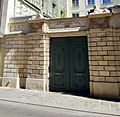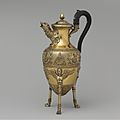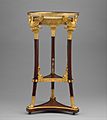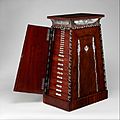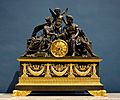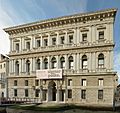Neoclassicism facts for kids

Neoclassicism is a style in art, architecture, and music that became popular in the 1700s. It was inspired by the art and culture of Ancient Greece and Ancient Rome. Think of it as a "new classicism" – artists looked back to the old ways for fresh ideas!
This style often focused on ideas like clearness, elegance, balance, and a sense of calm. Artists paid close attention to traditional shapes and forms from ancient times.
Contents
What is Neoclassicism?
Neoclassicism means "new classicism." It was a big movement in the arts that started around the mid-1700s and lasted until the early 1800s. People at this time were very interested in the ancient worlds of Greece and Rome. They studied their buildings, sculptures, and stories.
Why Did Neoclassicism Start?
This style became popular for a few reasons:
- Discoveries: Important ancient cities like Pompeii and Herculaneum were being dug up. This showed people what ancient Roman life and art were really like.
- New Ideas: Thinkers during the Age of Enlightenment believed in reason and order. They saw these qualities in ancient Greek and Roman societies and their art.
- Looking Back: After a period of very fancy and decorated art (like Rococo), many people wanted something simpler and more serious. Neoclassicism offered a return to clear, strong designs.
Main Ideas of Neoclassicism
Neoclassical art often shows:
- Order and Logic: Everything is carefully planned and balanced.
- Simplicity: Less fancy decoration, more focus on clear lines and shapes.
- Heroism: Many paintings and sculptures show brave heroes or important moments from history.
- Moral Lessons: Art often tried to teach good values, like duty and sacrifice.
Neoclassicism in Art
Neoclassical art is known for its smooth, ideal forms and serious subjects.
Painting
Neoclassical painters often used clear lines and bright colors. They focused on stories from ancient history or mythology.
- Famous Artists: One of the most famous Neoclassical painters was Jacques-Louis David from France. His paintings, like Oath of the Horatii, show strong emotions and clear messages about duty.
- Important Themes: Paintings often showed heroes, important historical events, or scenes that taught a moral lesson.
Sculpture
Sculptors in the Neoclassical period also looked to ancient Greek and Roman statues. They aimed for perfect, ideal human forms.
- Smooth and White: Many sculptures were made of white marble, looking like the ancient statues that had lost their paint over time.
- Famous Sculptors: Antonio Canova was a leading sculptor. His work, like Psyche Revived by Cupid's Kiss, shows graceful figures and smooth surfaces.
Neoclassicism in Architecture
Neoclassical architecture is probably the easiest place to spot this style. Many important buildings around the world use Neoclassical designs.
Building Features
You can often see these features in Neoclassical buildings:
- Columns: Tall, straight columns, often in styles like Doric, Ionic, or Corinthian, just like ancient temples.
- Pediments: Triangular shapes above entrances, like the roofs of ancient Greek temples.
- Domes: Large, rounded roofs, similar to the Pantheon in Rome.
- Symmetry: Buildings are often perfectly balanced on both sides.
Famous Examples
Many famous buildings around the world show Neoclassical style:
- The White House in Washington, D.C. is a great example of Neoclassical architecture in the United States.
- The Capitol Building in Washington, D.C., also has many Neoclassical features, including a large dome and columns.
- The Panthéon in Paris, France, started as a church and became a famous burial place. It looks like an ancient Roman temple.
- The Neue Wache in Berlin, Germany, is another example of a building designed with strong, simple Neoclassical lines.
Neoclassicism in Decorative Arts
The Neoclassical style wasn't just for big paintings and buildings. It also influenced everyday objects and furniture.
Furniture and Design
- Simple Shapes: Furniture became less curvy and more straight-lined and simple.
- Classical Motifs: Designs often included patterns from ancient Greece and Rome, like laurel wreaths, urns, and griffins.
- Materials: People used fine woods, often with bronze decorations.
- Famous Designers: People like Robert Adam in Britain designed entire rooms, including furniture, to have a unified Neoclassical look.
Neoclassicism was a powerful movement that brought back the ideas of order, reason, and classical beauty. It shaped art, architecture, and design for many years and still influences us today.
Images for kids
-
Psyche Revived by Cupid's Kiss; by Antonio Canova; 1787; marble; 155 cm × 168 cm; Louvre
-
Charles Towneley in his sculpture gallery; by Johann Zoffany; 1782; oil on canvas; height: 127 cm, width: 102 cm; Towneley Hall Art Gallery and Museum (Burnley, UK)
-
Oath of the Horatii; by Jacques-Louis David; 1784; oil on canvas; 3.3 x 4.27 m; Louvre
-
Château de Malmaison, 1800, room for the Empress Joséphine, on the cusp between Directoire style and Empire style
-
The West building (1941) of the National Gallery of Art in Washington
-
Fantasy View with the Pantheon and other Monuments of Ancient Rome; by Giovanni Paolo Panini; 1737; oil on canvas; 98.9 x 137.49 cm; Museum of Fine Arts (Houston, USA)
-
The ancient Capitol ascended by approximately one hundred steps . . .; by Giovanni Battista Piranesi; c. 1750; etching; size of the entire sheet: 33.5 × 49.4 cm; Metropolitan Museum of Art (New York City)
-
A Philosopher Lecturing on the Orrery; by Joseph Wright of Derby; c. 1766; oil on canvas; 1.47 x 2.03 m; Derby Museum and Art Gallery (Derby, England)
-
The Attributes of the Arts; by Anne Vallayer-Coster; 1769; oil on canvas; 90 x 121 cm; Louvre
-
Ariadne Abandoned; by Angelica Kauffmann; before 1782; oil on canvas; 88 x 70.5 cm; Gemäldegalerie Alte Meister (Dresden, Germany)
-
Julie Lebrun as Flora; by Élisabeth Vigée Le Brun; c.1799; oil on canvas; 129.5 x 97.8 cm; Museum of Fine Arts (St. Petersburg, Florida, USA)
-
Napoleon I on His Imperial Throne; by Jean-Auguste-Dominique Ingres; 1806; oil on canvas; 2.62 x 1.62 m; Army Museum (Paris)
-
Mercury or The Trade; by Augustin Pajou; 1780; marble; height: 196 cm; Louvre
-
The Winter; by Jean-Antoine Houdon; 1783; marble; height: 145 cm; Musée Fabre (Montpellier, France)
-
Central pavilion of the École Militaire (Paris), 1752, by Ange-Jacques Gabriel
-
Panthéon (Paris), 1758–1790, by Jacques-Germain Soufflot (1713-1780) and Jean-Baptiste Rondelet (1743-1829)
-
Commode of Madame du Barry; by Martin Carlin (attribution); 1772; oak base veneered with pearwood, rosewood and amaranth, soft-paste Sèvres porcelain, bronze gilt, white marble; 87 x 119 cm; Louvre
-
Stairway of the Grand Theater of Bordeaux (Bordeaux, France), 1777-1780, by Victor Louis
-
Parisian corner cabinet; by Jean Henri Riesener; 1780–1790; oak, mahogany, marble, and ormolu mounts; 94.3 × 81.3 × 55.9 cm; Art Institute of Chicago (US)
-
The Cabinet Doré of Marie-Antoinette at the Palace of Versailles (Versailles, France), 1783, by the Rousseau brothers
-
Panel win an arabesque in the Hôtel Gouthière (Paris), unknown date, unknown architect
-
Fan; by Charles Percier, Pierre-François-Léonard Fontaine and Antoine Denis Chaudet; c.1797-1799; paper, wood, and bone; 23.5 x 43.8 cm; Metropolitan Museum of Art (New York City)
-
Coffeepot; 1797–1809; silver gilt; height: 33.3 cm; Metropolitan Museum of Art (New York City)
-
Empress Joséphine's Bedroom in Château de Malmaison (Rueil-Malmaison, France), 1800-1802, by Charles Percier and Pierre-François-Léonard Fontaine
-
Portico of the Palais Bourbon (Paris), 1806-1808, by Bernard Poyet
-
Vase; 1809; hard-paste porcelain and gilded bronze handles; height: 74.9 cm, diameter: 35.6 cm; Wadsworth Atheneum (Hartford, Connecticut, US)
-
Egyptian Revival coin cabinet; by François-Honoré-Georges Jacob-Desmalter; 1809–1819; mahogany (probably Swietenia mahagoni), with applied and inlaid silver; 90.2 x 50.2 x 37.5 cm; Metropolitan Museum of Art
-
King of Rome's Cradle; by Pierre-Paul Prud'hon, Henri Victor Roguier, Jean-Baptiste-Claude Odiot and Pierre-Philippe Thomire; 1811; wood, silver gilt, mother-of-pearl, sheets of copper covered with velvet, silk and tulle, decorated with silver and gold thread; height: 216 cm; Kunsthistorisches Museum (Vienna, Austria)
-
La Scala Opera House, completed in 1778 by Giuseppe Piermarini
-
Palazzo Belgioioso, built in 1781 by Giuseppe Piermarini
-
Piazza del Popolo in Rome, redesigned between 1811 and 1822 by Giuseppe Valadier
-
Piazza del Plebiscito (1809 - 1846) in Naples
-
Palazzo Grassi built between 1748 and 1772 by Giorgio Massari on the Grand canal in Venice
-
Kedleston Hall (Kedleston, Derbyshire, England), 1760-1770, by Robert Adam
-
Eating Room (Osterley Park, London), 1761, by Robert Adam
-
Syon House (Middlesex, England), 1762, by Robert Adam
-
Carpet; by Robert Adam; 1770–1780; knotted wool; 505.5 x 473.1 cm; Metropolitan Museum of Art (New York City)
-
Apotheosis of Virgil; by John Flaxman; c.1776; jasperware; diameter: 41 cm; Harris Museum (Preston, Lancashire, UK)
-
Somerset House (London), 1776-1801, by William Chambers
-
Side table with many acanthus leafs and two bucrania; by Robert Adam; c.1780 with later addition; mahogany; overall: 88.6 × 141.3 × 57.1 cm; Metropolitan Museum of Art
-
Covered Wedgwood urn; c.1800; jasper ware with relief decoration; overall: 19.7 cm; Cleveland Museum of Art (Cleveland, Ohio, USA)
-
Maple secretary; circa 1790; maple and brass; height: 242.57 cm; Los Angeles County Museum of Art (US)
-
White House (Washington, D.C.), 1792-1829, by James Hoban
-
Capitol Building (Washington, D.C.), 1793-1863, by William Thornton and Thomas Ustick Walter
-
Federal Hill Mansion (My Old Kentucky Home State Park, Bardstown, Kentucky), 1795
-
The Rotunda (University of Virginia, Charlottesville, Virginia), by Thomas Jefferson, 1822-1826
-
South Carolina State House (Columbia, South Carolina), 1855, by John Rudolph Niernsee
-
James Dawkins and Robert Wood Discovering the Ruins of Palmyra, by Gavin Hamilton (1758)
-
Madame Raymond de Verninac by Jacques-Louis David, with clothes and chair in Directoire style. "Year 7": that is, 1798–1799
-
Portrait of Madame Récamier, by Jacques-Louis David, 1800
See also
 In Spanish: Neoclasicismo para niños
In Spanish: Neoclasicismo para niños










































